Community Education Health & Wellness
Peninsula’s cell phone policy a model for nearby school districts
Editor’s note: This article has been updated since it was first posted. Michele Suiter met with officials from Cle Elum, not Ellensburg.
Education Sponsor
Education stories are made possible in part by Tacoma Community College, a proud sponsor of Gig Harbor Now.
Last month, Michele Suiter hopped on a Zoom call with school officials from Cle Elum to offer guidance on cell phone policies. As more districts across the state move towards banning the devices, a handful have turned to the Gig Harbor High School principal for advice.
Suiter and her staff ran something of an unofficial pilot for the state last year, after the Peninsula School District adopted one of Washington’s first district-wide cell phone bans. Anytime a district introduces a sweeping policy it is bound to encounter hiccups, Suiter said. But in its second year, she believes the initiative has overwhelmingly delivered on reducing distractions.
“I was shocked three years ago when I would walk around and classes hadn’t begun yet and I would pop into a classroom and students would just all be sitting at their desks, (and) they’re all on their phones,” she said. “Now you’ll walk into a classroom and they’re saying hi to each other or they’re talking. There’s a lot less phones at lunch now too.”
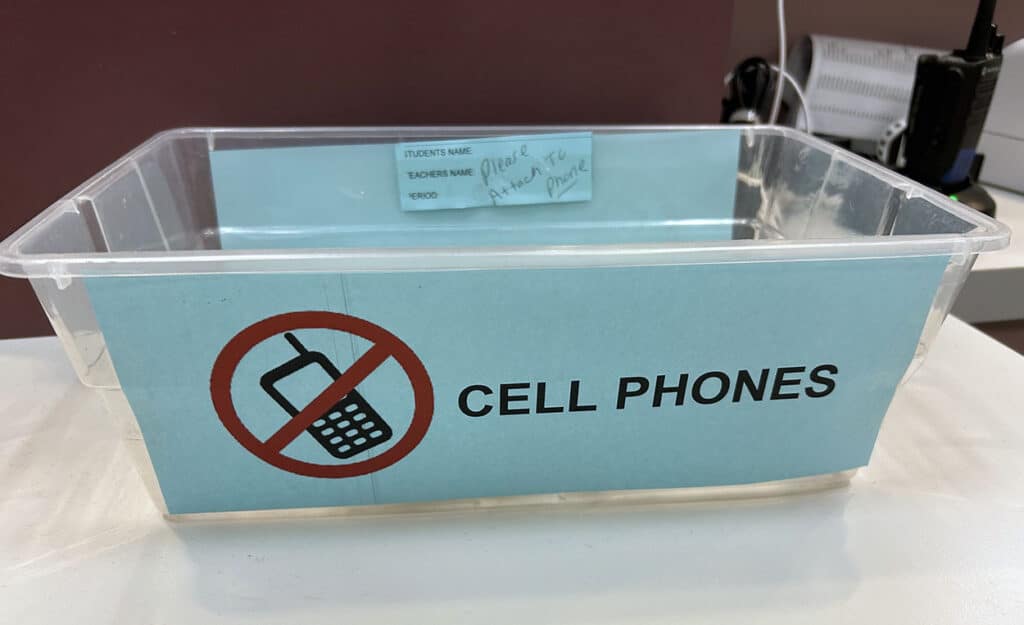
A bin for student cell phones in Goodman Middle School. Photo courtesy Peninsula School District
Cell phone ban a model for nearby districts
Success in Gig Harbor comes as more schools are looking to rein in cell phones. Four of the five school districts in Kitsap County now have bans, a pair of which are new this fall. Central Kitsap, the lone holdout, plans to have a ban by early next year.
Driving the surge is a reported increase in disruptive behaviors, bullying and poor mental health among students since they returned from the pandemic. Administrators and teachers believe those behaviors, to some degree, are linked to phones and social media.
“I’ll tell you, the first year that kids came back was very difficult,” said Ed Simmons, an eighth grade history teacher at Mountain View Middle School in Bremerton. “(Students) lost a whole year of development. Their bodies are telling them they’re developing, and all the chemicals are changing, but they weren’t getting any social development.”
For a decade, the Peninsula School District allowed its students to bring their phones to school and access social media on district networks. The school board changed that policy in August 2023, limiting phones outside of lunchtime and blocking social media apps.
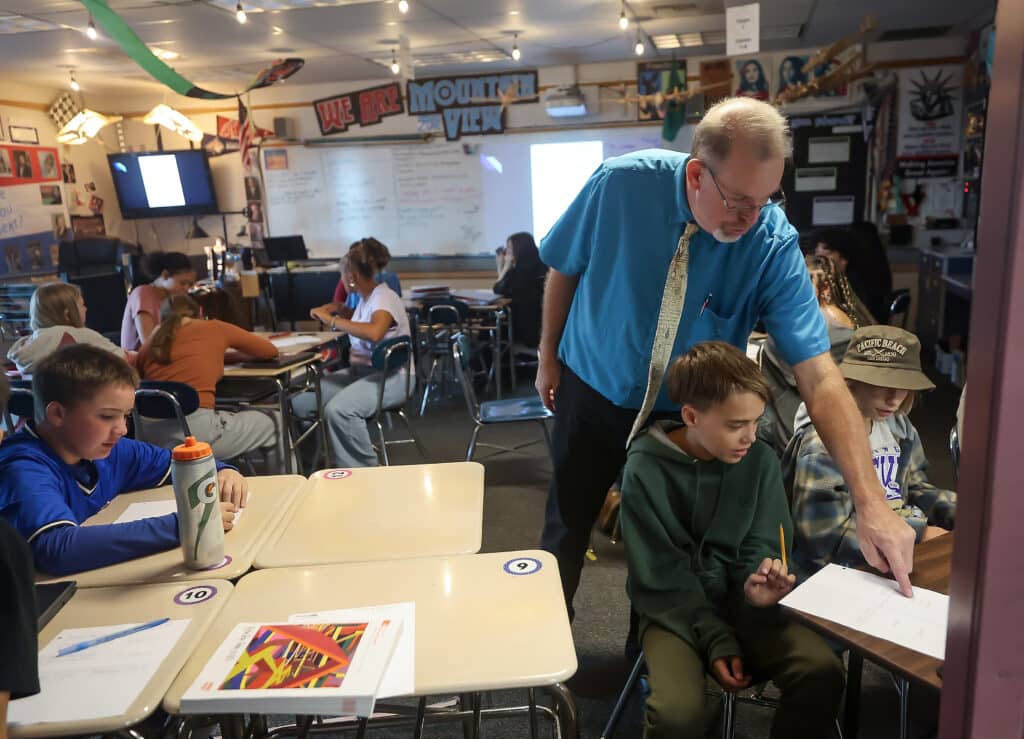
Mountain View Middle School teacher Ed Simmons talks with eighth-grade students Connor Bell, center, and Isaac Herdman, right, about an assignment during U.S. History class on Tuesday, Oct. 8, 2024. Photo by Meegan M. Reid/Kitsap Sun
‘Night and day’
“When the cell phone policy came out last year, I was like, ‘Thank the Lord,’” said Keyna Houston, a Gig Harbor High English teacher. “Finally I don’t have to fight this battle on my own. You come in, you put your phone in the caddy and we’re done.”
Houston said the difference between her classes has been “night and day.” Over the last decade-plus, she was constantly competing for students’ attention. Now they rarely bring up phones at all.
Houston and a handful of teachers in the English department began using phone caddies last year after the ban took effect. A majority of staff have moved to the phone holders this year. The consistency across classrooms has made it easier to enforce and alleviated many issues, she said.
The new policy was a bit shaky when the district implemented it, Gig Harbor High social studies teacher Leon Likens admits. But he said things have smoothed out.
Parents seem to be on board and students seem more engaged. Violations, Likens said, have “not really happened to any great effect.”
Students get over speedbumps
Jonah Eilers, a Gig Harbor senior, said the district’s phone policy has been generally positive for him and his peers.
While teachers say students appear to be interacting more, Eilers has not noticed much of a difference. However, he does feel less like he is missing out when away from his phone.
“You just check it after an hour and you don’t miss anything,” he said. “ I’ve kind of lost any feeling of missing out on things.”
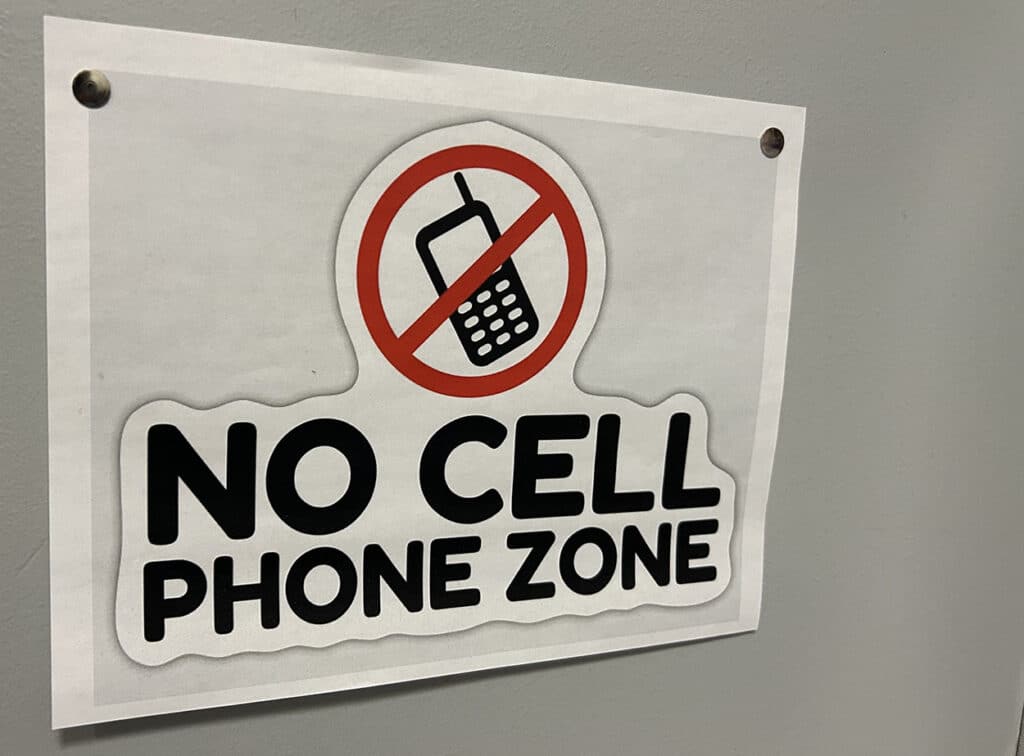
Peninsula School District cracked down on student cell phone use at the beginning of the 2023-24 school year. Photo courtesy Peninsula School District
Tiffany Clack, another senior, said some teachers were initially less willing to make expectations when students needed their phone to complete an assignment or make an important call. Most have become more lenient. Last year, she said, she got in trouble for being on her phone during class.
“It was for an important reason,” she said. “Once I explained to my teacher, I did not have any repercussions.”
Some teachers were also using their phone caddies to take attendance. Although the policy has since been clarified, it created problems early on when students left their phones at home or did not have them and teachers erroneously marked them absent.
Clack said she has come to see the benefits of the caddy on her productivity. She came around to the policy after teachers articulated they were trying to help, not force them to give up their phones without reason.
“We’re trying to prepare you, that’s taken a lot better than — ‘put it in the caddy. Get rid of it. Get it out of the way,’” she said.
Research lags
As schools implement bans, little research exists around their effects, said Lucía Magis-Weinberg, an assistant professor of psychology at the University of Washington. Last month, she announced plans to review bans at Western Washington schools, including in Gig Harbor and Seattle, as part of a larger study.
“Last year I had the chance to meet some staff from the Peninsula School District who were speaking about some changes they implemented in their school policies around smartphones and how happy they were,” she said. “We have been hearing that from other schools as well, but there’s been very little systematic research.”
Magis-Weinberg’s study comes amid growing backlash against social media and its impact on teens. The U.S. Surgeon General last year warned about the dangers of social media for young adults, saying a growing body of research suggested it could be harmful.
Magis-Weinberg, who researches the impacts of social media on adolescent mental health, said strong evidence suggests devices and social media are a distraction. But evidence they worsen mental health is less conclusive.
Research suggests a majority of students see rather small effects from social media, she said. But the effects can be significant particularly for vulnerable children, including those with underlying depression, body image issues or who are being bullied.
“There’s a time and a place for everything. And for smartphones and social media that’s exactly the case,” Magis-Weinberg said. “There’s all these risks, but also a lot of opportunities.”
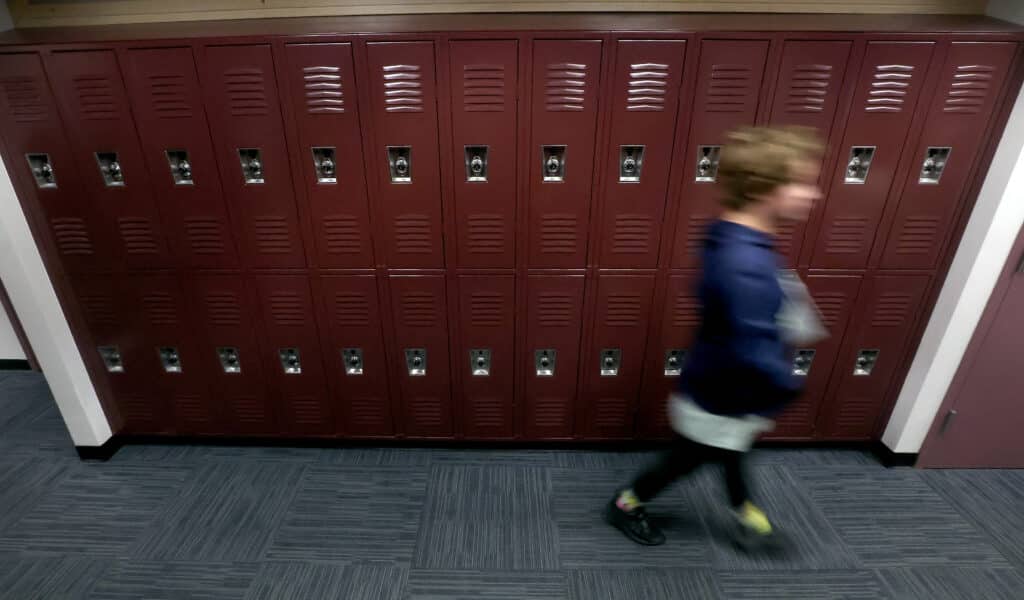
A student hurries past rows of lockers at Mountain View Middle School in Bremerton on Tuesday, Oct. 8, 2024. Students are required to leave their cell phones in their lockers during school hours. Photo by Meegan M. Reid/Kitsap Sun
Potential benefits of social media?
In an article from the American Psychological Association’s magazine experts say there is good reason to be concerned about social media and unmoderated content. But potential benefits exist for teens if proper and healthy boundaries are maintained.
“Teens (and adults) obviously get something out of social media,” Jacqueline Nesi, an assistant professor of psychology at Brown University who studies technology use on youth, told Monitor on Psychology, an APA magazine. “We have to take a balanced view if we want to reach teens and help them use these platforms in healthier ways.”
Clack, the Gig Harbor High senior, said many students get benefits from their phones because it allows them to collect themselves in between classes or after school.
“Going on your phone and brain rotting for a second or even catching up with a friend real quick. That’s kind of how we recollect before another class,” she said.
National energy
Long before Peninsula’s ban, school officials across the country were reporting frustration with phones. A national poll from the Pew Research Center found 72% of high school teachers said students being distracted by phones was a major problem. In response, eight states adopted laws regulating phone use during the school day, according to a database from KFF Health News.
“It’s not unique to our region or even our state,” said Erin Prince, superintendent of Central Kitsap School District in the Silverdale area. “More disruptive behaviors, lack of focus, more isolation for our students. Those types of behaviors became more prevalent post-COVID.”
Washington has not passed a phone ban at the state level. A bill introduced last year to create a pilot program looking at phone bans — co-sponsored by Rep. Michelle Caldier, R-Gig Harbor — stalled in the Legislature.
But weeks before students returned to class this fall, the state’s top education official published guidance that, while not binding, signaled a desire to curtail phone use. In his message, state Superintendent of Public Instruction Chris Reykdal called on all districts in the state to update their phone policies by next school year.
Phones off
Even before Reykdale’s message, though, districts on the Peninsula already had bans or restrictions on phones or were moving in that direction.
Spokespersons for South and North Kitsap school districts said while they already have policies regulating phone use, they plan to review them over the coming months in the wake of Reykdal’s message. Both districts require students to have their phones away during instructional time, with exceptions during breaks and lunch periods.
Prince, the Central Kitsap superintendent, sent an email to parents last spring saying they had seen a “troubling increase in disruptive and disrespectful student behaviors,” and pledged to review policies around phones and dress code this fall.
Until now, the district has left phone procedures to individual schools. It plans to adopt a district-wide policy by February. The investment comes amid a level of disruption that Prince says she has not witnessed in her decade-plus working as a superintendent.
“We’re worried about what the research is saying,” Prince said. “We are engaging in the work because of what we’re finding in our own classrooms.”
New bans
Bremerton and Bainbridge Island schools rolled out new bans this fall, with both reporting positive effects thus far.
Bainbridge High School requires students to keep their phones off and in either their bag or a phone caddy during instructional time, principal Kristina Rodgers said during a presentation last month. Phones are allowed during passing periods and lunch periods.
“Anecdotally, we do feel like we’ve seen less usage across the board,” she said, “even during times when students can have their phones out.”
A similar policy is in place at Bremerton schools. The district unveiled its “Mind Over Mobile Campaign,” placing phone restrictions at all secondary schools. Rules vary slightly between buildings. Bremerton High students can access phones outside of instructional times. Mountain View Middle School students, however, have no phone access during the day.
About a month into the policy, Simmons, the Mountain View history teacher, is encouraged by what he has seen. Students have accepted the policy and been more engaged with school and each other. He has yet to observe a phone in his classroom and notes that most parents have been supportive.
On the right track
If a student is found with a phone, Simmons says the teacher notifies administrators who take over at that point. They come to get the student’s phone and keep it in the main office until the end of the day.
Before the phone ban, Simmons described students as almost paralyzed by social media. They feared missing out on what was happening online. Many gave up on trying to be part of a broader community.
“Now is everything perfect? Of course not, I teach in a middle school,” Simmons said. “But we’re on the right track. We’re moving in the direction to get all the kids engaged.”
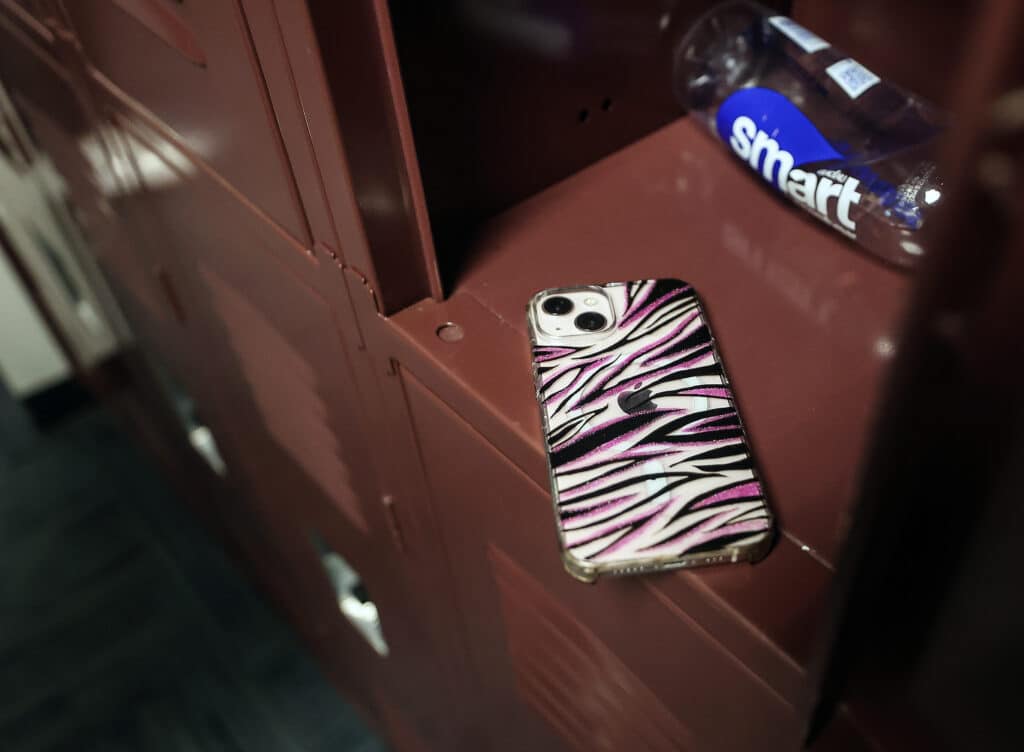
A student’s cell phone sits in a locker at Mountain View Middle School in Bremerton on Tuesday, Oct. 8, 2024. Students are required to leave their cell phones in their lockers during school hours.
Away from devices
Suiter, the Gig Harbor High principal, says even when she sees students on their phones at lunch now, it seems more social than before. Rather than using devices in isolation, students are sharing memes, Tik Toks or Instagram posts as a way of bonding.
The reasoning behind the phone policy, she said, was not to be punitive. After graduating, they want students to have a positive relationship with their devices and be able to unplug and engage when they need to.
“Even as adults we struggle,” she said. “We’ve talked about this as teachers, we struggle being away from our devices.”
As an administrator, Suiter says the last thing she wants is for her staff to be focused on anything other than teaching and connecting with students. The phone policy has helped them do that and improved the learning environment for students.
“Anytime you implement a new policy that’s so big you’re going to have a time where it’s gonna have a slump. Where you have to figure out and learn as you go” she said. “But for the most part I think it’s been pretty stable.”

